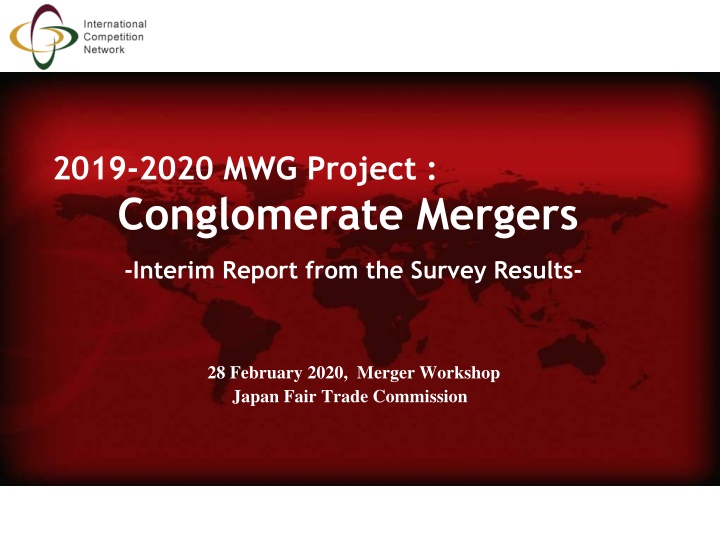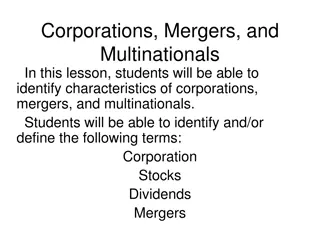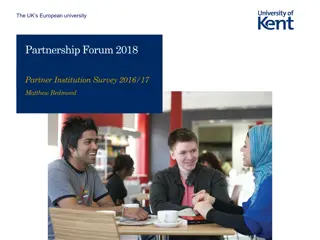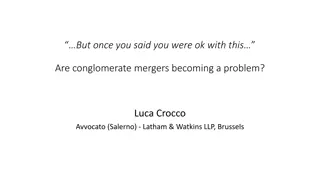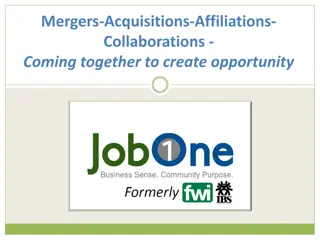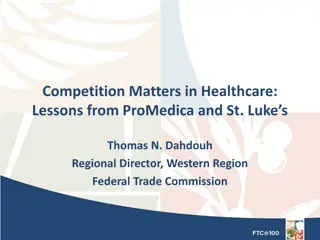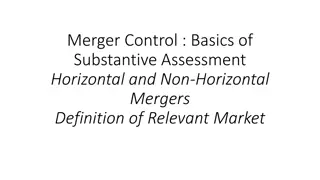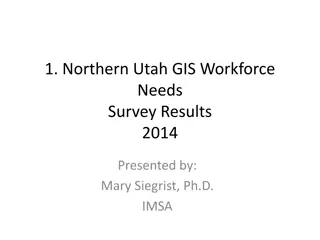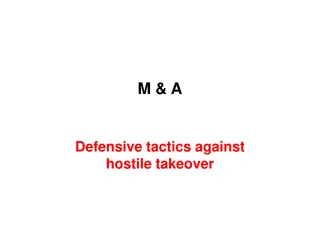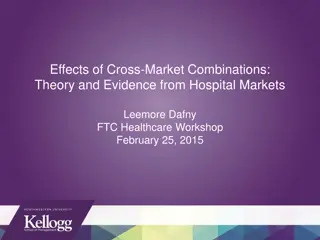Survey Results on Conglomerate Mergers: Review and Trends
This interim report presents key findings from surveys conducted on conglomerate mergers, including response rates, legal status, statistics, assessment approaches, theories of harm, and more. The survey highlights the evolving nature of conglomerate merger assessments and the importance placed on understanding conglomerate theories relative to horizontal and vertical theories.
Download Presentation

Please find below an Image/Link to download the presentation.
The content on the website is provided AS IS for your information and personal use only. It may not be sold, licensed, or shared on other websites without obtaining consent from the author.If you encounter any issues during the download, it is possible that the publisher has removed the file from their server.
You are allowed to download the files provided on this website for personal or commercial use, subject to the condition that they are used lawfully. All files are the property of their respective owners.
The content on the website is provided AS IS for your information and personal use only. It may not be sold, licensed, or shared on other websites without obtaining consent from the author.
E N D
Presentation Transcript
2019-2020 MWG Project : Conglomerate Mergers -Interim Report from the Survey Results- 28 February 2020, Merger Workshop Japan Fair Trade Commission
Outlines of the Results of Survey (1) Response Rate: 53.2% (33 / 62 authorities) Legal status on conglomerate mergers review; Ability to review conglomerate mergers? GL specifically address conglomerate mergers? Mergers Guidelines(GL)? NO 4 NO 6 YES 23 NO 7 YES 16 YES 29 (79.3%) (69.6%) 87.9% GL provide framework for assessing? GL discuss evidence? GL provide case examples? NO 3 YES 6 NO 5 YES 13 YES 11 NO 10 (37.5%) (81.3%) (68.8%) 2
Outlines of the Results of Survey (2) Statistics in last 5 years; all types of mergers conglomerate mergers 28 # of authorities 15 12 10 Prohibition cases 5 4 3 5 2 2 1 1 1 1 0 0 0 0 0 0 0 0 0 0 0 0 # of cases 0 1 2 3 4 5 6 7 8 9 over 10 21 # of authorities 20 Clearance with remedies /conditions 15 9 10 5 4 4 4 3 2 2 5 0 0 0 0 0 0 # of cases 0 1-5 6-10 11-30 31-50 51-100 over 101 Structural remedies Behavioural remedies All types of mergers 57% 43% Types of remedies /conditions Vertical mergers 12% 88% Conglomerate mergers 25% 75% 0% 10% 20% 30% 40% 50% 60% 70% 80% 90% 100% 3
Outlines of the Results of Survey (3) Approach to the assessment of conglomerate mergers is still evolving on 68% authorities responding to the survey Importance of conglomerate assessment relative to horizontal or vertical mergers; Higher priorit relative to vertical/horizontal theories 0 y Lower priority Same priority relative to horizontal theories 15 (50%) relative to vertical theories 17 (56.7%) relative to horizontal theories 7 (23.3%) relative to vertical theories 9 (30%) Much lower relative to horizontal theories 8 (26.7%) priority relative to vertical theories 4 (13.3%) Not examimne conglomerate theories 0 4
Outlines of the Results of Survey (4) Theories of Harm; YES NO Tying/Bundling 92% 8% Foreclosure Sharing confidential information 68% 32% Other 8% 92% Elimination of potential entrant 71% 29% Other 12% 88% 0% 20% 40% 60% 80% 100% Considering Coordinated Conduct: 64% of authorities Considering Efficiencies: 84% of authorities 5
Outlines of the Results of Survey (5) Assessment of Theories of Harm Reviewed by internal documents/data from merging parties, and also, documents/data/interview results from third parties (customers, suppliers, competitors, analysts, etc.) Theories of Harm Assessment /Evidence Foreclosure (tying, bundling, sharing confidential information, etc.) Considering ability, incentive and likely effect: 100 % (all) of the authorities - market power of the merging parties in each market - links between products, i.e. complementarity of products (synergies), customer overlap, customer preferences - competitors ability to take effective and timely counter strategies, etc. Ability - profit of the merged party (balance between possible gains and cost of tying/bundling) - strategies/plans how the merging parties will market the products, etc. Incentive - proportion and significance of competitors who are foreclosed, and who are still able to provide a constraint over the merged party - significance of the input to the production process of downstream rivals, etc. All over effect of foreclosure Elimination of potential entrant Possibility of entry - entry costs/risks and profitability - specific entry plan, resources, capabilities, etc. Effect of elimination - number of competitors or number of other potential entrant in the market - the potential entrant s existing presence in the relative market, etc.. 6
Outlines of the Results of Survey (6) Industries in which conglomerate concerns may be greater; - digital/IT sector (8 authorities) - education, energy, mass consumption products (food, household products, etc.) (3 authorities) - healthcare, financial service (2 authorities) Case Studies; Some cases from member authorities including digital/IT platform, media, foods, chemical products, machinery components, etc. International Cooperation; 52% of the authorities have not cooperated with other competition agencies on conglomerate mergers review 7
Teleseminars - Conglomeratemergers on October 29, 2019 - Acquisitions of nascent competitors on January 21, 2020 (also a part of webinar series of the digital mergers project) Report - Survey results - Discussion points of the teleseminars - Breakout session in the 2020 annual conference 8
